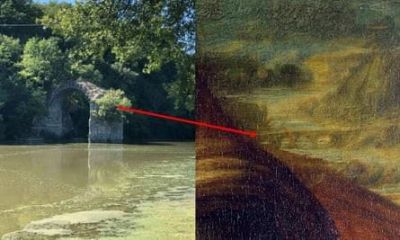A small town in Tuscany is revelling in excitement after it was claimed that the bridge painted in the backdrop of the most famous portrait in the world – Leonardo da Vinci’s Mona Lisa – belongs to the town. The Italian historian Silvano Vinceti said he had no doubt that the Romito di Laterina bridge in the province of Arezzo was what Leonardo had painted into the countryside landscape behind the enigmatic Mona Lisa, which would end a mystery that has fuelled countless disputes over the years. Leonardo painted the Mona Lisa in Florence in the early 16th century, and the identity of the woman featured in the oil painting – widely believed to be Lisa del Giocondo – has triggered as much speculation as the distant backdrop. Theories in the past have identified the bridge as Ponte Buriano, close to Laterina, as well as Ponte Bobbio in the northern Italian city of Piacenza. Using historical documents and drone images, and by making comparisons between the painting and photographs of the area, Vinceti said it was “the Etruscan-Roman bridge, Romito”. The most telling detail, he told reporters at the foreign press association in Rome, was in the number of arches: the bridge in Leonardo’s painting had four arches, as did the Romito. Ponte Buriano, on the other hand, has six arches, while Ponte Bobbio has more than six. Only one arch of the Romito, which stretched across the Arno river, remains as do the foundations of the bridge on the opposite side of the riverbank. Documents belonging to the Medici family that were found in Florence’s state archives showed that between 1501 and 1503 the bridge was “a very busy, functioning bridge”, Vinceti said. He added that it was precisely at that time that Leonardo was in the Val d’Arno area, first at the service of Cesare Borgia, a cardinal from the most notorious noble family in Renaissance Italy, and then for Piero Soderini, a statesman of the Republic of Florence. Vinceti has made several other claims about the Mona Lisa in the past, including that Leonardo used a male and female model in the portrait, which hangs behind a bulletproof glass in the Louvre in Paris.
Un piccolo villaggio in Toscana è molto lieto dopo aver confermato che il ponte sullo sfondo nel famoso dipinto, Mona Lisa, di Leonardo da Vinci, è il ponte in questo villaggio. Lo storico Silvano Vinceti ha dichiarato di non avere dubbi che il ponte, Romito di Laterno, sia quello che Da Vinci dipinse nel dipinto “Monna Lisa”. Questa affermazione ha finalmente chiuso il mistero della provenienza di questo ponte. La pittura è stata dipinta a Firenze nel XVI secolo. L'identità della donna non è ancora nota, ma molti storici ritengono che si tratti di Lisa del Giocondo. Sebbene l'identità della donna non sia nota con certezza, per molti anni non si sapeva nemmeno dove fosse il fondo. Vinceti ha finalmente detto che non c'è più confusione e il ponte è Romito. La prova più significativa è stata quante arcate ci sono nel ponte del Romito. Anche se ci sono storici che hanno detto che si trattava del ponte di Buriano o di Bobbio, Vincenti ha spiegato che questi ponti non hanno quattro arcate. Nel dipinto, un arco attraversa anche il fiume Arno come raffigurato. Vincenti ha anche detto che ci sono stati documenti scoperti dalla famiglia Medici datati dal 1501 al 1503 che dicono che il ponte era molto pieno e affollato nei giorni in cui di Vinci fu in Val d'Arno quando lavorava per Cesare Borgio e poi per Piero Soderini. Vincenti attesta anche che di Vinci usò un modello maschile oltre che un modello femminile per dipingere la Gioconda.



